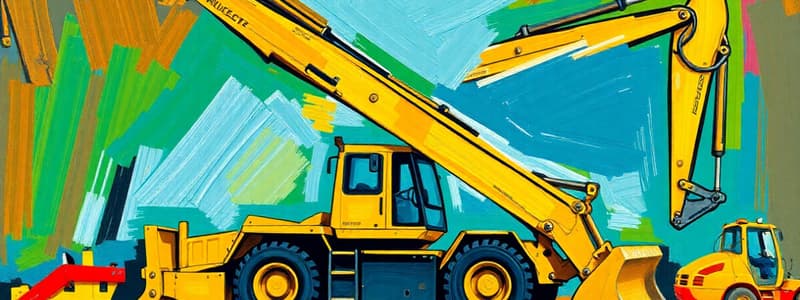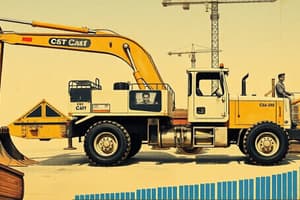Podcast
Questions and Answers
Which of the following is NOT considered an operating cost for machines?
Which of the following is NOT considered an operating cost for machines?
- Fuel
- Tires or tracks
- Repair and maintenance
- Depreciation (correct)
What aspect of ownership costs generally decreases with the age of equipment?
What aspect of ownership costs generally decreases with the age of equipment?
- Interest rates
- Maintenance costs
- Insurance premiums
- Depreciation value (correct)
Which of the following items is classified as a high wear item?
Which of the following items is classified as a high wear item?
- Engine oil
- Taxes
- Ripper tips (correct)
- Operator fees
What is the primary goal of equipment procurement in construction?
What is the primary goal of equipment procurement in construction?
What is included in machine operating costs?
What is included in machine operating costs?
Which depreciation method maintains a consistent reduction in asset value over time?
Which depreciation method maintains a consistent reduction in asset value over time?
Which method is considered the best for estimating ownership and operating costs?
Which method is considered the best for estimating ownership and operating costs?
What are ownership costs NOT composed of?
What are ownership costs NOT composed of?
What is a key factor that influences the decision to purchase or rent/lease equipment?
What is a key factor that influences the decision to purchase or rent/lease equipment?
Which of the following components is NOT typically included in calculating ownership costs?
Which of the following components is NOT typically included in calculating ownership costs?
What factors affect the Life Cycle Cost of operating a machine?
What factors affect the Life Cycle Cost of operating a machine?
What happens to ownership costs if a machine is not used frequently?
What happens to ownership costs if a machine is not used frequently?
If a new machine costs $260,000 and has a salvage value of $0 after 8 years, what would be the total ownership expense?
If a new machine costs $260,000 and has a salvage value of $0 after 8 years, what would be the total ownership expense?
Flashcards
Equipment Procurement Goal
Equipment Procurement Goal
Providing the right equipment at the right time and place to complete work at the lowest cost.
Depreciation
Depreciation
A decrease in the value of equipment over time due to wear, tear, or obsolescence.
Straight-Line Depreciation
Straight-Line Depreciation
A depreciation method that spreads the cost of an asset evenly over its useful life.
Ownership Cost
Ownership Cost
Signup and view all the flashcards
Life Cycle Cost
Life Cycle Cost
Signup and view all the flashcards
Machine Production Rate
Machine Production Rate
Signup and view all the flashcards
Unit Cost
Unit Cost
Signup and view all the flashcards
Ownership Cost Calculation
Ownership Cost Calculation
Signup and view all the flashcards
Operating Costs of Machines
Operating Costs of Machines
Signup and view all the flashcards
High Wear Items
High Wear Items
Signup and view all the flashcards
Ownership Costs vs. Operating Costs
Ownership Costs vs. Operating Costs
Signup and view all the flashcards
Estimating Equipment Costs
Estimating Equipment Costs
Signup and view all the flashcards
Economic Useful Life
Economic Useful Life
Signup and view all the flashcards
Study Notes
Construction Equipment
- Studying equipment operation costs is crucial for bidding and construction planning.
- The goal of equipment procurement is to provide the right equipment at the right time and place, allowing work to be done at the lowest cost.
- Efficient machine utilization impacts purchasing or renting/leasing decisions.
Economics - Depreciation
- Depreciation is the loss of value in construction equipment due to wear, tear, and obsolescence.
- Common depreciation methods include Straight-Line (SL), Sum-of-the-Years (SOY), and Declining Balance (DB).
Depreciation Accounting
- Depreciation accounting estimates current market value.
- It allocates depreciation over a period to determine billing rates.
- It's used to maximize tax benefits.
- Usually, there are two or three depreciation methods used for one piece of equipment by the owner simultaneously. These methods are used for internal purposes to calculate billing rates, determining company's net worth, and for IRS estimations.
Calculating Depreciation
- To determine depreciation, these factors must be known:
- Purchase price (P)
- Economic life (n or N)
- Salvage value (F or S)
Depreciation Accounting Methods
- The common depreciation methods include Straight-Line, Sum-of-the-Years, and Declining Balance.
- Straight-Line: Equipment depreciates equally each year.
- Sum-of-the-Years: Depreciation is higher in the early years of life, gradually decreasing.
- Declining Balance: Depreciation is maximum in the first year, then decreases, often not reaching salvage value. A double-declining balance (DDB) is the maximum permitted rate.
Straight-Line Method (SL)
- Equipment depreciates equally over its useful life.
- This is a simple method used to estimate repair and maintenance costs.
- Annual depreciation rate (R) = 1 / N
- Annual depreciation amount (D) = R * (P - F)
- Book value (BV) = BVm-1 - Dm
Straight-Line Example
- A tractor's purchase price is 150,000,withanestimatedsalvagevalueof150,000, with an estimated salvage value of 150,000,withanestimatedsalvagevalueof70,000 after 8 years.
- The annual depreciation amount is $10,000 using the straight-line method, and the book value at the end of each year of use can be determined using the formula.
Sum-of-the-Years Method (SOY)
- This method has a non-uniform depreciation rate, higher in initial years, and gradually decreases.
- Annual depreciation rate (Rm) = (N - m + 1) / SOY
- SOY = N(N + 1) / 2
Declining-Balance Method (DB)
- Maximum depreciation occurs in the first year.
- The method doesn't automatically reach salvage value.
- Annual depreciation rate (R): can range from 1.25 to 2 depending on the desired acceleration. R = X / N.
- Annual depreciation amount (Dm): (BVm-1) * R
Double-Declining Balance Method
- X = 2 is the maximum depreciation rate in the DDB method.
- Depreciation cannot fall below estimated salvage value.
Comparisons and Uses
- DDB depreciates equipment faster than SOY or Straight-Line. DDB is preferred for tax purposes.
- SOY is often used to determine book value.
- Straight-Line is often used for maintenance and repair cost estimations.
Summary
- Construction equipment loses value with time.
- Book Value (BV) is the value at the end of each year after depreciation has been deducted. BVm = BVm-1 - Dm
- Depreciation calculation varies by method:
- Straight-Line: Equal depreciation each year.
- Sum-of-the-Years: Higher initial depreciation.
- Declining Balance: Highest depreciation in the first year, percentage based on previous year's book value.
Economics - Ownership and Operating Costs
- Life Cycle Cost: Total cost of operating equipment over its lifetime.
- Ownership costs: Costs associated with owning the equipment whether used or not. includes depreciation , insurance, taxes, salvage value, and shop expenses. Purchase price - salvage value + Overhead = Ownership expense.
- Operating costs: Costs associated with using the equipment. Includes items such as fuel, oil, grease, filters, repair, maintenance, tires or tracks, and other wear and tear items like cutting edges.
- Ownership costs typically decline with age due to depreciation. Operating costs tend to increase with age due to higher repair costs.
- Use time value of money analysis to estimate useful life based on hours of use
Studying That Suits You
Use AI to generate personalized quizzes and flashcards to suit your learning preferences.




